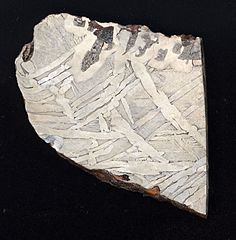Iron-nickel meteorite
| Iron meteorite | |
|---|---|
| — Type — | |

|
|
| Compositional type | Iron |
| Parent body | >50 |
| Composition | Fe, Ni & Co (>95%), Ni (5%-25%) |
| TKW | ~500 short tons (450 t) |
 Widmanstätten pattern as seen on an etched and polished slice of the Seymchan meteorite. Scale unknown. |
|
Iron meteorites are meteorites that consist overwhelmingly of an iron–nickel alloy known as meteoric iron that usually consists of two mineral phases: kamacite and taenite. Iron meteorites originate from planetary cores of planetesimals.
The iron found in iron meteorites was one of the earliest sources of usable iron available to humans, before the development of smelting that signaled the beginning of the iron age.
Although they are fairly rare compared to the stony meteorites, comprising only about 5.7% of witnessed falls, iron meteorites have historically been heavily over-represented in meteorite collections. This is due to several factors:
Because they are also denser than stony meteorites, iron meteorites also account for almost 90% of the mass of all known meteorites, about 500 tons. All the largest known meteorites are of this type, including the largest—the Hoba meteorite.
Iron meteorites have been linked to M-type asteroids because both have similar spectral characteristics in the visible and near-infrared. Iron meteorites are thought to be the fragments of the cores of larger ancient asteroids that have been shattered by impacts. The heat released from the radioactive decay of the short-lived nuclides 26Al and 60Fe is considered as a plausible cause for the melting and differentiation of their parent bodies in the early Solar System. The IIE iron meteorites may be a notable exception, in that they probably originate from the crust of S-type asteroid 6 Hebe.
Chemical and isotope analysis indicates that at least about 50 distinct parent bodies were involved. This implies that there were once at least this many large, differentiated, asteroids in the asteroid belt – many more than today.
...
Wikipedia
